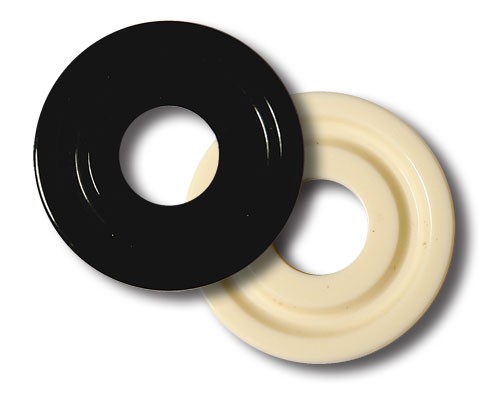|
D. The DVONN-potential
Use of the special ability
The DVONN-potential has a hole in the middle.........................
1. The DVONN-potential
has the ability to jump on top of an opponent's piece. It may jump
on top of:
- an opponent's basic piece;
- an opponent's basic piece loaded with a
DVONN-potential;
- an opponent's DVONN-potential that has jumped
on top of one of your own basic pieces or DVONN-potentials.
In other words: it may not jump onto a GIPF-piece, nor onto any
other type of potential.
2. To use a DVONN-potential:
take it from the basic piece (i.e. "unload" the loaded
piece) and jump onto an opponent's piece on an adjacent spot.
3. Jumping onto an
opponent's piece counts as a turn, meaning that you make a move
with a DVONN-potential instead of playing with a piece from your
reserve.
4. You neutralize
an opponent's piece when you jump with a DVONN-potential on top
of it, but you set it free again when you must take the DVONN-potential
from the board (i.e. when it is part of a row that must be removed).
In other words, your colour occupies the spot for as long as your
DVONN-potential stays on top of the opponent's piece; when you remove
the potential, it is the opponent's piece underneath it that occupies
the spot again.
5. The consequences
of jumping with a DVONN-potential on top
of an opponent's piece are exactly the same as when playing with
a piece out of the reserve. E.g. a row of four can be the result
of a jump. BUT! When removing a row which contains a used DVONN-potential,
you must leave the piece(s) underneath the potential on the board.
It is very important to understand that the rule above only concerns
DVONN-potentials on top of an opponent's piece, thus on top of the
opposite colour. If it is on top of its own color, it concerns a
regular loaded piece and a loaded piece must always be removed as
a whole (cf. General use, point 6). So:
- If you want to remove one of your own pieces
that is loaded with a DVONN-potential: remove the loaded piece
as a whole;
- If you capture an opponent's pieces that
is loaded with a DVONN-potential: remove the loaded piece as a
whole;
- If you remove one of your own DVONN-potentials
with which you have jumped on top of an opponent's piece: only
remove the DVONN-potential (i.e. you must leave the piece(s) underneath
it on the board);
- If you capture an opponent's DVONN-potential
that has jumped on top of one of your pieces: only remove your
opponent's DVONN-potential (i.e. leave the piece(s) underneath
it on the board).
Reminder: a used potential (regardless
its colour) may not be left on the board when it is part of a row
that must be removed (cf. General use, point 8).
6. It can happen that
you create a new row of four by removing a DVONN-potential. If you
remove one of your own DVONN-potentials, the result may be a row
or four for your opponent (i.e. you set free the opponent's piece
underneath it, which may be the fourth piece in a row). If you capture
an opponent's used DVONN-potential, the result may be a new row
of your own colour (i.e. by setting free one of your own pieces).
These are particular cases. As in regular GIPF, each row that must
be removed must be seen as "one entity." So, always deal
with rows one by one, and apply the following rules very strictly:
- When it is your turn, first check whether
your opponent has formed a row of your colour. If so, you must
remove it.
- If you capture an opponent's used DVONN-potential
and, by setting free your piece underneath it, create a new row,
you must remove that row, too.
- If you remove one of your own used DVONN-potentials
and, by setting free the opponent's piece underneath it, form
a row for your opponent, that row remains on the board. The reason:
you haven't made a move yet.
- Then, after having dealt with the rows of
your colour (if any), you must make a move. You may use the move
to break an opponent's row if you have just created one by removing
a DVONN-potential.
- After having made a move, you must again
remove the rows of your colour (if any).
- If you capture an opponent's used DVONN-potential
and, by setting free your piece underneath it, you create a new
row, you must remove that row, too.
- If you remove one of your own used DVONN-potentials
and, by setting free the opponent's piece underneath it, you form
a row for your opponent, he must remove that row as soon as it
is his turn.
7. If, towards the
end of a game, you have no more basic pieces in reserve but still
one or more pieces on the board that are loaded with a DVONN-potential,
you may continue the game by making use of the DVONN-potentials
- if they are in a position where they can be used.
The DVONN-potential can be used with or without
connecting DVONN to GIPF. If you play without DVONN, you may use
the special ability of the potential as described above, without
further notice. First try it out at least a few times like that
before you start combining games.
|

